Es frustrante intentar visitar una página web y solo encontrarse con un error de ‘Página no encontrada’. Esto puede dañar su marca y sus visitantes pueden simplemente irse a otro sitio web.
En WPBeginner, entendemos que los enlaces rotos pueden dañar la experiencia del usuario y el SEO. Por eso utilizamos All in One SEO para redirigir a nuestros usuarios al contenido que están buscando.
Cuando alguien visita su sitio utilizando un enlace antiguo a una página que se ha movido, una redirección 301 le llevará automáticamente a la nueva página para que no vea un error 404 ‘Página no encontrada’.
En este artículo, te mostraremos cómo crear redireccionamientos 301 en WordPress utilizando All in One SEO y otras herramientas para que puedas ofrecer una mejor experiencia de usuario y mejorar el posicionamiento de tus palabras clave.

¿Qué es una redirección en WordPress?
Una redirección es una forma de que su sitio web WordPress envíe automáticamente a los usuarios a una nueva dirección cuando la página que desean visitar ha sido movida o reemplazada. Esto es similar a la forma en que una oficina de correos redirige su correo cuando se cambia de casa.
Existen varios tipos de redireccionamientos que se identifican con números como 301, 302 y 307. Dirigen automáticamente el navegador / explorador de su usuario a una URL diferente cuando intenta visitar una página que no existe.
En esta guía para principiantes, nos centraremos en las redirecciones 301, ya que son el tipo más importante. Indican al navegador que la página se ha movido permanentemente a la nueva ubicación y que no tiene intención de volver a moverla.
Dicho esto, veamos cuándo debe utilizar una redirección 301.
¿Cuándo se necesita una redirección 301 en WordPress?
La principal razón para utilizar una redirección 301 es cuando su sitio o una página de su sitio se ha movido, y desea dirigir al usuario a una nueva página en su lugar.
También es necesario cuando se planea cambiar el permalink de una entrada o página.
Si no establece la redirección, los usuarios verán un error 404 cuando la página no se encuentre. Esto proporciona una mala experiencia de usuario y puede afectar a tu SEO en WordPress.

También puede perder backlinks valiosos si hay muchos enlaces rotos en su sitio. Esto provocará una caída significativa de la autoridad de su dominio y de su clasificación por palabras clave.
Por eso las redirecciones 301 son muy importantes. Permiten indicar a los motores de búsqueda y a los usuarios que la página a la que intentan acceder se ha trasladado permanentemente a una nueva ubicación.
De este modo, todo el tráfico y los backlinks de su antigua página se transfieren a la nueva.
Ahora, echemos un vistazo a cómo puede crear redirecciones 301 en WordPress. Le mostraremos cómo hacerlo fácilmente con varios plugins de redirección de WordPress y manualmente usando código.
Tutorial en vídeo
Si prefiere instrucciones escritas, siga leyendo.
Método 1: Crear redireccionamientos 301 con el plugin AIOSEO
La forma más sencilla de gestionar y crear redireccionamientos 301 es con el plugin para WordPress All in One SEO (AIOSEO). Es el mejor plugin SEO para WordPress y lo utilizan más de 3 millones de profesionales para mejorar el SEO de sus sitios.
AIOSEO ofrece una potente extensión para la gestión de redireccionamientos que hace que sea muy fácil encontrar enlaces rotos en su sitio web y establecer redireccionamientos 301 para corregirlos.
Nota: Necesitará AIOSEO Pro para utilizar el gestor de redirecciones. También hay una versión gratuita de AIOSEO, pero no incluye redirecciones 301.
En primer lugar, debe instalar y configurar el plugin AIOSEO Pro en su sitio web. Para obtener más información, consulte nuestra guía paso a paso sobre cómo establecer All in One SEO correctamente.
Una vez que el plugin esté activo, tendrá que ir a All in One SEO ” Redirects en su escritorio de WordPress y luego hacer clic en el botón ‘Activar Redirects’.
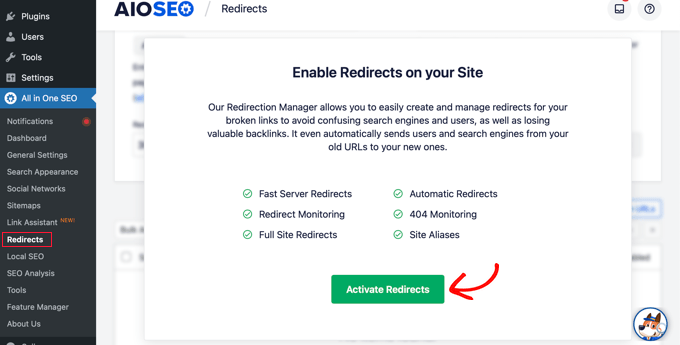
A continuación, puede hacer clic en la pestaña “Ajustes” y seleccionar “PHP” como método de redirección.
Este es el método más sencillo para crear redireccionamientos y no requiere ninguna configuración del lado del servidor.
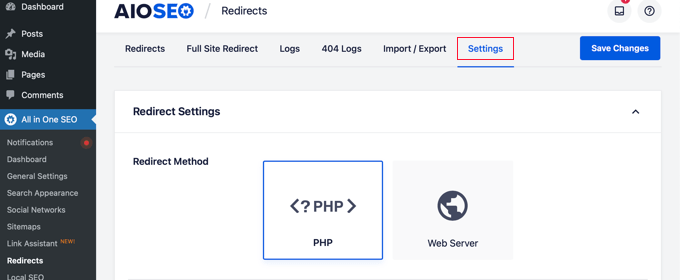
AIOSEO también le permite seleccionar el método de redirección del servidor web. Sin embargo, requiere configurar Apache o NGINX en su servidor web. Esto requiere conocimientos técnicos y no es recomendable para principiantes.
Creación de redireccionamientos 301
Ahora está listo para crear redirecciones 301. Para primeros pasos, dirígete a la pestaña ‘Redirección’.
En primer lugar, introduzca el enlace que desea redirigir en el campo “URL de origen”. A continuación, introduzca el nuevo destino del enlace en el campo “URL de destino”.
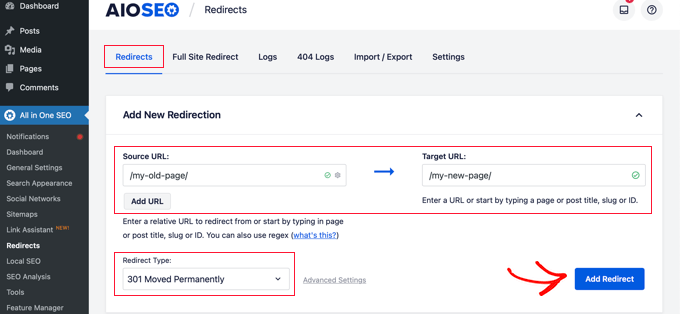
Ahora asegúrese de que el Tipo de redirección es “301 Movido permanentemente” y, a continuación, haga clic en el botón “Añadir redirección”.
Si desea redirigir varias URL a una nueva ubicación, sólo tiene que hacer clic en el botón “Añadir URL” situado bajo el campo URL de origen.
A continuación, puede desplazarse hacia abajo para ver los registros de las redirecciones que ha creado. Muestra el número de personas que visitaron el enlace enlazado en la columna “Hits” y una opción conmutadora para activar o desactivar redireccionamientos 301 individuales.

Añadir redirecciones 301 para corregir errores 404
AIOSEO también puede ayudarle a hacer un seguimiento de las páginas de error 404 y a corregirlas.
Para activar esta opción, tiene que desplazarse hasta la sección ‘Registros de redireccionamiento’ en la pestaña de ajustes. A continuación, active las opciones “Registros 404” y “Registros de redireccionamiento”.
También puede seleccionar el periodo de tiempo que desea conservar los registros. Recomendamos guardarlos durante un mes como máximo para que el rendimiento del servidor sea rápido y sin problemas.
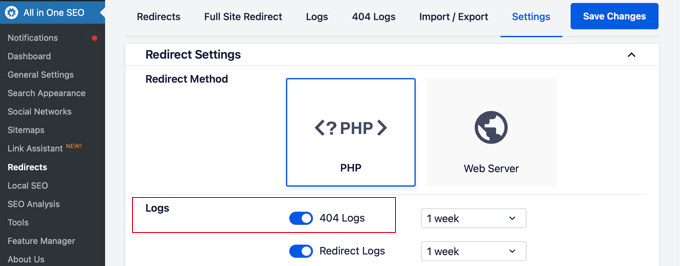
Después de activar estas opciones, asegúrese de hacer clic en el botón “Guardar cambios”.
Ahora debería ver una nueva pestaña ‘404 Logs’ en la sección Redirecciones. Aquí es donde AIOSEO seguirá y mostrará sus enlaces rotos y le permitirá establecer redirecciones. También verá el número de visitas al enlazar bajo ‘Hits’ y la última fecha y hora de acceso.
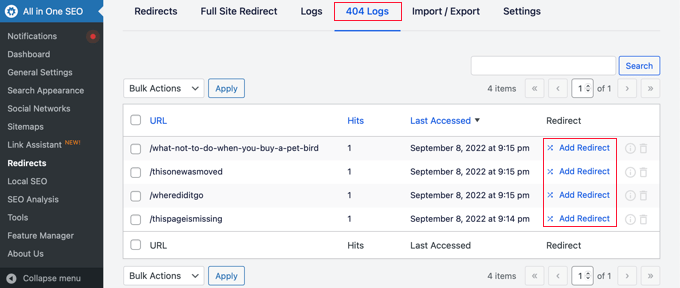
Nota: No encontrará ningún dato cuando active por primera vez los registros 404. El plugin solo empieza a registrar páginas de error 404 una vez que se ha activado / activo el ajuste.
A continuación, haga clic en el enlace “Añadir redirección” situado junto a la URL del error 404 que desea redirigir. No se trata del botón de la parte inferior.
Ahora verá opciones para introducir una URL de destino y seleccionar el tipo de redirección en el menú desplegable.

Introduzca su nueva URL y elija ‘301 Moved Permanently’ como tipo de redirección. Ahora debe hacer clic en el botón “Añadir redirección”.
AIOSEO creará una redirección 301 para su enlace roto. Para ver si la redirección está funcionando correctamente, simplemente visite la antigua URL para comprobar si se le lleva al nuevo destino.
Añadir redirecciones 301 directamente desde una entrada o página
AIOSEO también le permite redirigir una entrada o página publicada mientras la está editando.
Si te desplazas hasta el final de la página en el editor de WordPress, encontrarás una sección de ajustes de AIOSEO. Tienes que hacer clic en la pestaña ‘Redirecciones’.
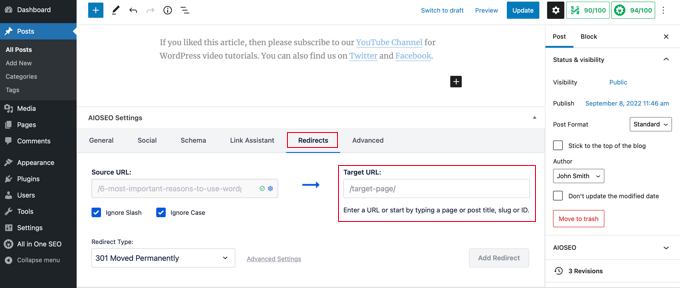
La URL de origen se ha rellenado para usted. Sólo tiene que introducir la nueva URL en el campo “URL de destino” y seleccionar “301 Movido permanentemente” en el menú desplegable Tipo de redirección.
Además, si cambia el permalink de una entrada mientras la edita, AIOSEO le ofrecerá redirigir la URL antigua a la nueva.
En cualquier caso, haga clic en el botón “Añadir redirección” y ya está.
Redireccionamiento de sitios web completos
Si traslada su sitio web a un nuevo nombre de dominio, es posible que sus visitantes encuentren enlaces rotos y que el SEO de su sitio se resienta.
Puede utilizar AIOSEO para mover todo su sitio web a una nueva ubicación sin perder tráfico ni posicionamiento en buscadores. Se trata de una redirección 301 del sitio completo.
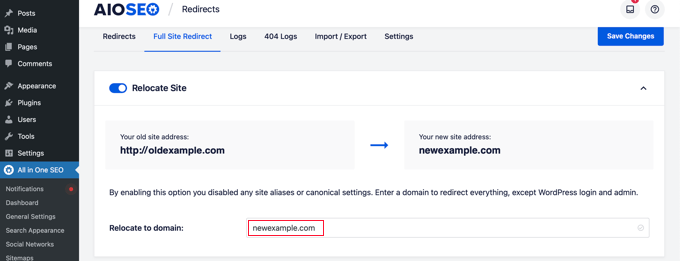
Es importante que lo haga de la forma correcta, por lo que hemos creado una guía práctica para principiantes sobre cómo realizar una redirección completa del sitio con WordPress.
Método 2: Crear redireccionamientos 301 con el plugin Redirection
Otra forma de añadir y gestionar redirecciones en WordPress es con el plugin Redirection.
En primer lugar, debe instalar y activar el plugin. Puedes seguir nuestra guía detallada sobre cómo instalar un plugin de WordPress.
Nota: Aunque establecer redireccionamientos 301 mediante un plugin de WordPress es fácil, tiene algunos inconvenientes menores de rendimiento. Dependiendo de tu proveedor de alojamiento WordPress, tus redirecciones pueden ser unos microsegundos más lentas que con otros métodos.
Si quieres que tus redirecciones sean lo más rápidas posible, entonces puedes hacerlo editando tu archivo .htaccess usando el Método 5 de abajo.
Una vez activado, visite Herramientas ” Redirección y, a continuación, haga clic en el botón “Iniciar configuración”.
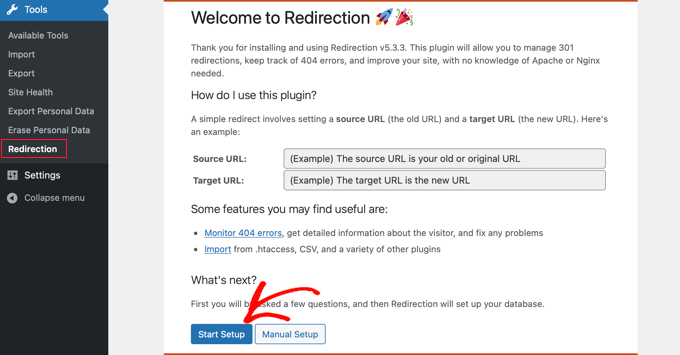
A continuación, puede seleccionar opciones para supervisar los cambios de permalink en WordPress y mantener un registro de todas sus redirecciones y errores 404.
Sólo tiene que activar estas opciones y hacer clic en el botón “Continuar configuración”.
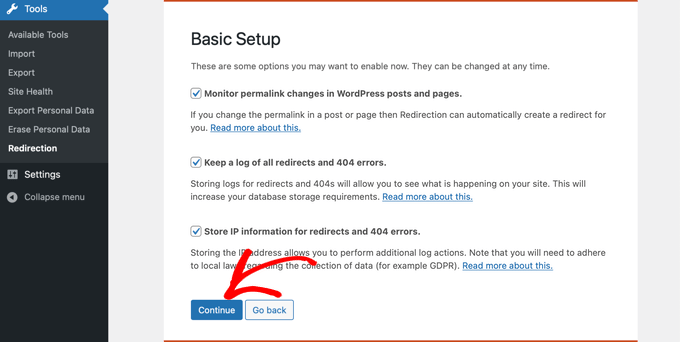
Ahora el plugin probará automáticamente la API Rest.
Cuando el estado vuelva a ser Bueno, siga adelante y haga clic en el botón “Finalizar configuración”.
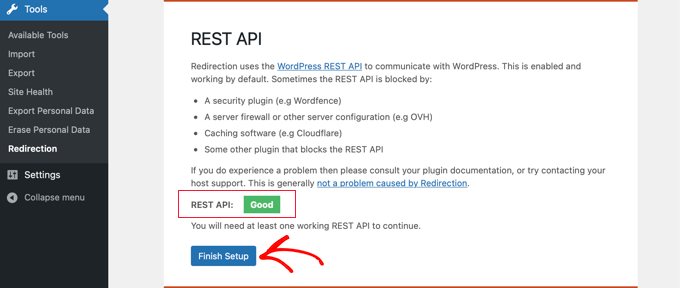
El plugin de redirección realizará algunas tareas más para completar su configuración. Cuando la barra de progreso alcance el 100%, puede hacer clic en el botón “Continuar” y, a continuación, en el botón “Listo para comenzar”.
El plugin ya está listo para que crees tus redirecciones 301. Para primeros pasos, vaya a la sección Herramientas ” Redirección de su panel de WordPress. Debe mirar la sección “Añadir nueva redirección” en la parte inferior de la pantalla.
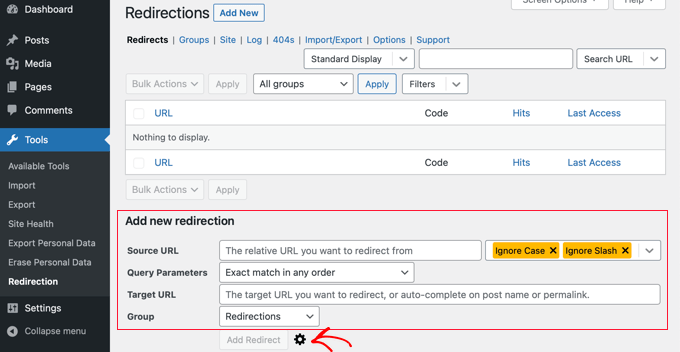
Verás los ajustes básicos para añadir una redirección. Sin embargo, si haces clic en el icono del engranaje, verás más opciones para elegir el tipo de redirección.
Sólo tiene que introducir la URL de origen de su antigua página y añadir la URL de destino a la que desea redirigir. Asegúrate también de que la opción de código HTTP está establecida en ‘301 – Moved Permanently’.

Una vez que haya introducido todos los datos, siga adelante y haga clic en el botón “Añadir redirección”.
Método 3: Crear redirecciones 301 con el plugin Simple 301 Redirects
Una de las formas más sencillas de crear redireccionamientos 301 es con el plugin Simple 301 Redirects. Como su nombre indica, hace que las redirecciones 301 sean realmente sencillas.
Para empezar, tendrá que instalar y activar el plugin en su sitio web.
A continuación, visite Ajustes ” Redirecciones 301. Aquí puede introducir la URL antigua en el campo “Solicitud” y la URL de destino en el campo “Destino”.

Una vez hecho esto, haga clic en el botón “Añadir nuevo” para crear la redirección 301. Y ya está.
Los redireccionamientos 301 simples comenzarán a funcionar inmediatamente.
Método 4: Redireccionar Páginas Existentes Con Enlaces A Plugins
A veces es posible que desee mantener un anuncio en el feed de su sitio o una página de una determinada manera en su sitio, pero tienen el contenido alojado en otro lugar. Aquí es donde el plugin Page Links To resulta útil.
Una vez que instalas y activas el plugin, éste añade una caja meta a tu editor de WordPress. Aquí puedes introducir la dirección de la nueva ubicación a la que quieres enviar a tus usuarios.
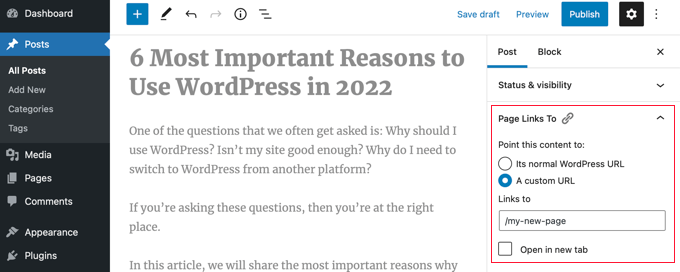
Cuando pulse “Actualizar” o “Publicar”, WordPress tratará la entrada o página de forma normal, pero cuando alguien la visite, será redirigido a la URL personalizada que haya elegido.
Por ejemplo, puedes tener un blog en el que ocasionalmente creas contenido descargable, pero quieres que los usuarios del sitio de tu tienda online vean ciertas entradas como productos. Puedes utilizar este plugin para hacerlo sin arriesgarte a que Google te penalice por contenido duplicado o a dividir tu base de usuarios.
Método 5: Creación manual de redireccionamientos 301 mediante .htaccess
Los usuarios de WordPress también pueden establecer redireccionamientos 301 editando el archivo de configuración del servidor web .htaccess.
Por favor, tenga en cuenta que un pequeño error en su código .htaccess puede hacer que su sitio WordPress sea inaccesible, y puede empezar a mostrar el Error Interno del Servidor.
Por eso es importante que haga una copia de seguridad de su archivo .htaccess antes de realizar cualquier cambio.
Edite su archivo .htaccess con el plugin SEO All in One
Si tiene instalado el plugin All in One SEO, le ofrece una forma sencilla de editar su archivo .htaccess.
Nota: Necesitará All in One SEO Pro para utilizar el editor .htaccess.
Simplemente visite la página Herramientas de SEO Todo en Uno y cambie a la pestaña ‘.htaccess Editor’.
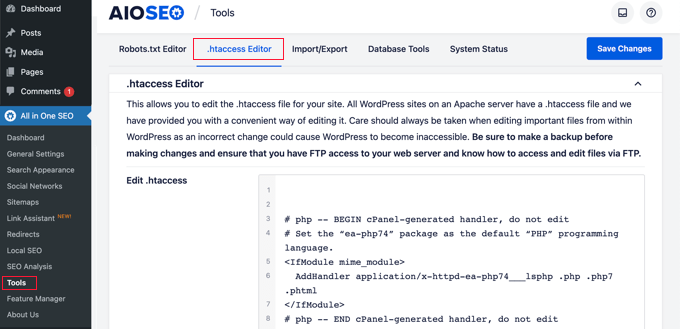
Desde aquí, verá el contenido de su archivo .htaccess en el editor. Usted puede simplemente colocar cualquier código de redirección que desee añadir en la parte inferior después de la línea ‘# END WordPress’.
Aquí hay una redirección simple donde estamos tratando de enviar a un usuario que visita una entrada antigua a una entrada nueva.
RewriteEngine OnRedirect 301 /a-very-old-post/ http://yoursite.com/a-very-new-post/ |
No olvide cambiar la URL de la entrada antigua y de la nueva. Cuando haya terminado, haga clic en el botón “Guardar cambios” para establecer sus ajustes, y All in One SEO actualizará su archivo .htaccess.
Edite directamente su archivo .htaccess de WordPress
También puede editar directamente su archivo .htaccess de WordPress para establecer cualquier redirección.
Para editar su archivo .htaccess, deberá conectarse a su sitio web mediante un cliente FTP. El archivo .htaccess se encuentra en el directorio raíz de su sitio WordPress.
Si no puede ver su archivo .htaccess, consulte nuestra guía sobre por qué no puede encontrar el archivo .htaccess en su sitio WordPress.
Puede descargar .htaccess a su ordenador y editarlo con un editor de texto como el Bloc de notas.
Puede utilizar este código de redirección para enviar a un usuario que visite una entrada antigua a una entrada nueva. Debe pegar el código al final de su archivo .htaccess después de la línea ‘# END WordPress’.
RewriteEngine OnRedirect 301 /a-very-old-post/ http://yoursite.com/a-very-new-post/ |
Asegúrese de cambiar la URL de la entrada antigua y de la nueva. Después de eso, puede guardar los cambios y subir el archivo .htaccess de nuevo al servidor.
Ahora puede probar la redirección para asegurarse de que se realiza correctamente.
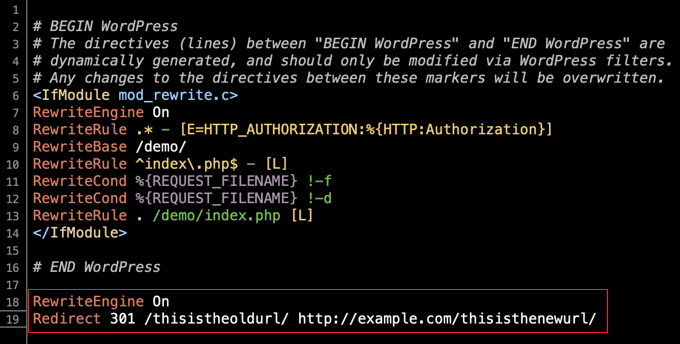
Además, también puede acceder al archivo .htaccess y modificarlo a través del panel de control y el gestor de archivos integrado de su proveedor de alojamiento.
Por ejemplo, puedes encontrar tu .htaccess en el gestor de archivos de SiteGround yendo a Herramientas del sitio “ Sitio “ Gestor de archivos y navegando hasta la carpeta /public_html/ de tu sitio.
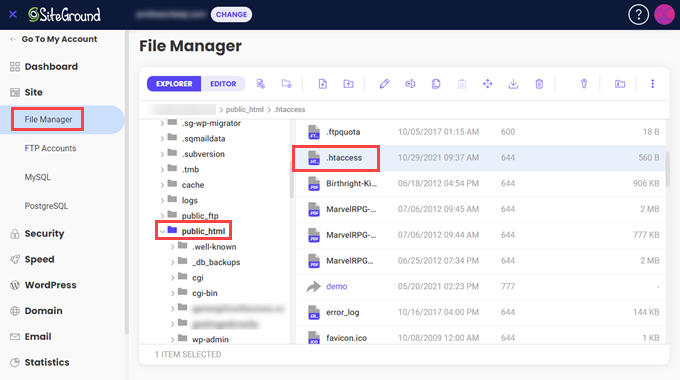
A continuación, puede hacer clic con el botón derecho del ratón en el archivo .htaccess y seleccionar “Editar”.
Sólo tiene que añadir el código de redirección 301 directamente y guardar el archivo. De nuevo, asegúrese de descargar el archivo .htaccess original como copia de seguridad.
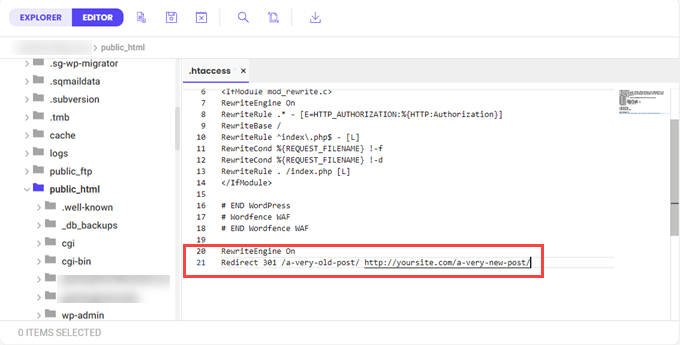
Esperamos que esta guía para principiantes sobre cómo crear redireccionamientos en WordPress te haya ayudado a establecer redireccionamientos en tu sitio. También puedes consultar nuestra guía sobre cómo redirigir una página o URL en WordPress o nuestra selección de los mejores plugins de redirección para WordPress.
If you liked this article, then please subscribe to our YouTube Channel for WordPress video tutorials. You can also find us on Twitter and Facebook.




Nick Grainger
Hi, thanks for the helpful article above.
I have switched the permalink format from plain to post, and used the AISEO Pro Redirect function to redirect to the new page URLs. That all seems to be working fine – but now I can’t edit the pages. The system seems to be looking for the original plain format page address to edit. Help!
Thanks in advance for your advice. Nick
WPBeginner Support
The WordPress editor uses the Post ID so changing the permalinks should not affect the editor. Please be sure to clear any caching and if you’re on a localhost installation, ensure you have mod_rewrite enabled in the tool you are using.
Admin
Lori Michelle
So I am just trying to understand. We have a wordpress website oldname.com. We rebranded the company and would love to use newname.com, but don’t want to lose any hyperlinks floating out in the world. Can I use the 301 redirect for the whole website on this website? Am I making sense? Help!!!
WPBeginner Support
To change your site’s domain we would recommend taking a look at our article below!
https://www.wpbeginner.com/wp-tutorials/how-to-properly-move-wordpress-to-a-new-domain-without-losing-seo/
Admin
Lori
So I do need to set it up somewhere else, I can’t just change the website URL name and 301 it that way, is that correct?
WPBeginner Support
If you are setting it up on the same hosting provider then you would be able to go to the 301 redirect step as long as you set up the site on the new domain.
Sean
What if you want to redirect a few specific blog posts to a new domain? For example: example.com/blog/hello-world to newsite.com/blog/hello-word. BUT, you don’t need to redirect ALL the old blog content. Just a few specific URLs?
WPBeginner Support
If you wanted it to go to a completely new URL, you would want to place the full URL in the target URL field.
Admin
Donald McKenzie
If I remove comments from my blog, do I need a redirect for the material that was removed. Not the post, just the comments.
WPBeginner Support
No, you shouldn’t need to create redirects for comments that were removed.
Admin
Donald McKenzie
Thank you very much for getting back to me.
WPBeginner Support
Glad we could be helpful
Kanka
Hi, I have a post that I want to delete however after deleting it I plan on redirecting it to a page. Is this okay?
WPBeginner Support
Yes, you can do that, as long as you have the correct URL for your redirect it should be fine
Admin
Kanka
What about the opposite situation which is redirecting a deleted page to a post?
WPBeginner Support
Yes, it works in both directions as long as you redirect the correct URLs.
Anka
I actually don’t have any problems while doing redirects, however, I have more than 50 redirects and plan to do more. Does this cause a problem as I also need to delete categories and some posts?
Rhea
Is there a way I can schedule a redirect?
James
Is there a way to bulk upload redirects via a csv file? It would be handy
WPBeginner Support
The plugin has an option to import via CSV
Admin
hamada
i have made redirection with plugin “Redirection”then i deleted the redirection item from Redirection’s setting ,but i want to get it back the same what should i do
WPBeginner Support
The simplest method would be to recreate the redirect rather than attempting to restore it.
Admin
Esmaeil
I have transfer my site from a domain to a brand new domain. how can I do the 301 redirect without entering address by address?
I mean I want to define something like this : all URLs of example.com goes to example.net for example.
thank you so much in advance.
WPBeginner Support
You would want to take a look at the redirect in our article below:
https://www.wpbeginner.com/wp-tutorials/how-to-properly-move-wordpress-to-a-new-domain-without-losing-seo/
Admin
Tim
I have the redirects set up and working great, but I have a question about finding and replacing all these redirected urls.
Is there a way to find/replace them across your complete WordPress site? Not just within the WordPress database, but also within personal HTML code, and urls within tables using TablePress added to the website.
I’m looking for a global find/replace solution, is there one?
WPBeginner Support
You could either use an analytics tool to find where the link is on your site or you could take a look at a plugin from our previous article below:
https://www.wpbeginner.com/plugins/search-and-replace-plugin-for-wordpress-database/
Admin
Diana
Is there any chance I can implement 301 in free WordPress.com? It says I’m not allowed to install plugins. Only if I’m on business plan. And I want to migrate to WordPress.org
WPBeginner Support
For moving your site from WordPress.com to org you would want to go through our guide below: https://www.wpbeginner.com/wp-tutorials/how-to-properly-move-your-blog-from-wordpress-com-to-wordpress-org/
Admin
Farukh Hussain
Hi,
I have done a redirect some time ago using ‘Redirection’ plugin.
But now I cant find that url in the plugin. Even there is no code for that url in htaccess file too.
I want to disable that redirect now. Is there any way to do this? Pls help?
WPBeginner Support
If the redirect is not in the plugin, you would want to check your htaccess file or reach out to your hosting provider for their assistance with finding the redirect.
Admin
Ginger
If I’m redirecting several web pages (not posts), do I make duplicates of the code you showed above (both lines 1 and 2) for each of the new page I am redirecting? And do I keep copying those codes at the bottom of the .htaccess file?
I read another article that suggests adding redirection codes in the functions.php file in the theme folder. The code is long and seems complicated. But I wonder, which option is more efficient — editing the .htaccess or editing the functions.php?
WPBeginner Support
You would add a new version of the second line of code, you only need the first line once. For where the redirect happens it is personal preference on which method is best.
Admin
Lindsey
Hi
Apparently my site has a 301 redirect on it, but I cannot discover where this is, nor what it is redirecting. There is nothing in the htaccess file. The site was originally built using a different name on localhost, and all the urls were changed to become the new domain name. Could this be the problem? How do I track down where the 301 is because it is causing problems with the SSL certificate. Thanks
WPBeginner Support
Updating the urls shouldn’t be an issue if they were updated correctly. If you reach out to your hosting provider they should be able to help you find what is causing the redirect.
Admin
Jessica
I can’t thank you enough for this simple guide as I’ve always been told to not touch redirects unless you know what you’re doing, so my seo suffered a bit because I ended up not doing anything. Fact is, I know enough and can follow instructions if they’re not written for developers and I don’t have to rely on a plugin that may cause problems later ’cause they all do at some point, right? Thank you. This link is going in my toolbox to share with others having the same problem.
WPBeginner Support
You’re welcome, glad our guide could be helpful for you and anyone you share it with
Admin
Wendy
I used the method in the video, but my site still has Uncategorized listed at the top and the side. I tried to find the third part of the video about changing the 301 redirect links in my settings, but it is not there. However, when I click on Uncategorized it changes to general, but when I visit my site again or refresh it is back to Uncategorized. The plugin for redirects said it was compatible with my theme. Any help is appreciated, thank you.
WPBeginner Support
It sounds like you’re trying to remove the uncategorized category from your site. If that’s the case you would want to take a look at our article here: https://www.wpbeginner.com/beginners-guide/rename-the-uncategorized-category/
Admin
Hannah
Hey there! thank you for the helpful info! I am wondering does this plugin work for a change of domain on my blog? I recently changed my domain and read that it is very important to implement a 301 redirect in order to not lose rankings and exposure. Would this do the trick? If so, would I put my old domain in the source line and the new domain in the target line?
Thank you!
WPBeginner Support
You would want to take a look at steps 4 and 5 in our article here: https://www.wpbeginner.com/wp-tutorials/how-to-properly-move-wordpress-to-a-new-domain-without-losing-seo/
Admin
Matt
Can I use “page links to” and “redirection” one the same site?
They seem like they serve different needs, but I have seen warnings that you shouldn’t use more than one redirection plugin at a time. True?
I like redirection features, but I like having something on the “edit post” view that I can use to set up a redirect (e.g., teaser/excerpt linking out to a landing page or to another site). Thanks!
WPBeginner Support
We would not recommend using the two plugins at the same time to prevent any conflicts between the two, you could check with the plugin authors for if there is a recommended method for the two plugins to work together.
Admin
Bill
I migrated a WP website to a new domain and set up a redirect from the old domain to the new one within cPanel. The redirects are nearly instantaneous (that’s good, right?) but I’d like to delay them for a few seconds, long enough to display a screen on the old homepage explaining why they’re being redirected.
I’m not a programmer. Is there a plugin that will allow me to adjust the time before the redirect occurs? TIA
WPBeginner Support
Unless I hear otherwise, we do not have a simple method we would recommend to set that up sadly.
Admin
Lee
Hello,
A great post by the way.
I have numerous pages which have been redirected to new urls, I have updated all page link urls to the new urls, so no broken links on front end.
My question is after a few months is it safe to delete any redirects which were created?
Many thanks.
Lee
WPBeginner Support
If there are no references to the broken links you could remove the redirects, otherwise it may be best to keep the redirects active.
Admin
Matthew
Hi, I have been using the redirection plugin for a while now trying to sort my old posts out from when I first started ( the permalinks were awful )
What I have been doing is creating another post with a better permalink and copy and pasting the content from the old URL to the new one and then 301 redirecting them.
After reading this post I’m starting to think that I don’t need to create a completely new post but just change the permalink on the old one and redirect it like that, Am I Correct?
If so, can I delete all the old duplicate posts from before or should I leave them as they are?
Thanks if you can help
WPBeginner Support
Correct you can modify the permalink and redirect without the need for the old post to be active. As long as the redirects are in place you can remove the old posts if you wanted.
Admin
Matthew
So just to clarify, I can delete the old posts that I copied and pasted into a new one and redirected the URL, and that all I have to do is to modify the permalink and not copy and paste the whole URL into a different post but just redirect the old permalink to the new one?
Thanks so much for replying to me, you have saved me so much time if that’s the case
WPBeginner Support
Correct, glad we could help
Damion Mower
Once I have set up the redirect, what do I do with the original post, delete it?
WPBeginner Support
While not required, most people do that if they no longer want the old post.
Admin
Focussed Events
Thank you this is just what I was looking for!
WPBeginner Support
Glad we could provide the answer you were looking for
Admin
Lekan
After setting a redirection can I trash the page?
WPBeginner Support
Yes you can
Admin
Wilbert Beltran
Hi, I recently duplicated a site. Let’s say the original site’s url is original.com and I created a subdomain http:testsite.orginal.com where the duplicate site is located. Now, the question is how do I do the redirection with this kind of setup. I want to make the site at original.com to be the main site.
Thanks
WPBeginner Support
For moving your site from a subdomain, you would want to take a look at our article here: https://www.wpbeginner.com/wp-tutorials/how-to-properly-move-wordpress-from-subdomain-to-root-domain/
Admin
Gina
Hi – thank you for this! Love you guys. I downloaded the plugin and have redirected some pages. Can you tell me if I should redirect mysite.com to miresite.com/ – how do I do that? somewhere along the line the “/” fell away. There were 4 different redirect plugins on the WP site I am working on for a client and the site crashed last week – I deactivated them all and installed this one – all is good except for the/ thing. Am I even asking a logical question?
WPBeginner Support
You shouldn’t need to worry about redirecting the site to an address with a / at the end
Admin
Gina
Hi – I have now discovered that my page mydomian.com/ is being redirected to mydomain.com – without the /
I don’t know where this happened or how except from possibly one of the plugins I downloaded?? It is a 301 and I do not know now if this has damaged anything? All the search results show the address with the /. but when the result is clicked it go to the non /. please can you help or send me to somewhere that can help of fix
WPBeginner Support
You would first want to take a look at your plugins if any of them are designed for redirects you would want to see if that is set there. If none of those are causing the redirect you would want to see if the redirect is created in your htaccess file or under Settings>General if the address was changed there.
Tom
Great, thank you, I went with the .htaccess redirect, exactly what I was looking for.
WPBeginner Support
Glad we could help
Admin
Vinca
does this work the same for 302 redirects in an htaccess file? A client has asked to 302 redirect around 800 urls from a wordpress site to a Wix site. There are moments when it all operates fine, then we get several 404’s. Not sure if it’s because there are way too many urls or if we are overlooking something?
WPBeginner Support
The htaccess method would work for 302 redirects if you changed the number to 302. 302 redirects are temporary which could be part of your problem as well as your caching.
Admin
Md firoz ahmed
I have a WordPress site. I face some problem. I am using the woo commerce plugin. Woocommerce site automatically added product category page in my permalinks as- google.com/product-category/up/this-is-my-page. I want to redirect this link like- google.com/this-is-my-page. how can i solve this? any help
WPBeginner Support
For editing WooCommerce’s permalinks, you would want to check under Settings>Permalinks to modify them. If you take a look at WooCommerce’s documentation they explain more in depth.
Admin
Daniel Akinyele
Hi, Wp beginnger, if you could help me i will be do happy, I used the Htacces code and it worked perfectly. But i want My Media Files to redirect to itself,
So is there a code to stop The d=redirection in Wp-contents Folder..pls help me my Website is Dieing
Fahad
Great Information helps me to get out of a serious issue
Michael Wright
Thanks for this! I needed the Redirect plugin. Didn’t know it was a thing
Emmanuel Ekanem
Hello, does this redirection works for a URL complete change?
For example, I’m using olddomain.com and I bought newdomain.com, and want to redirect olddomain.com to open up newdomain.com.
Any help on that??
WPBeginner Support
Hi Emmanuel,
If you do that on your old website, then you will not be able to access it as the plugin will redirect you and your users to new domain name.
Admin
Emmanuel Ekanem
Oops, so how can I achieve this?
WPBeginner Support
You can do that by adding the following code to the .htaccess file on your old site.
RewriteEngine onRewriteCond %{HTTP_HOST} ^oldomain.com [NC,OR]RewriteCond %{HTTP_HOST} ^www.olddomain.com [NC]RewriteRule ^(.*)$ http://newdomain.com/$1 [L,R=301,NC]1-click Use in WordPress
Mauwiks
How can I redirect a single homepage to another domain but the rest of the pages from my redirected domain won’t be affected?/
Lovelyn Montepop
Thank you for this guide. Helped me a lot for a client’s request.
Kavitha
I have a subdomain for affiliate store. I want to know how to redirect from my site page to subdomain page. Please help.
Maegen
Thank You so so much! I have been blogging for about 8 months and have worked so hard to build my Pinterest account. It is where almost all my traffic comes from. A month ago I changed over to https and I didn’t realize until last night that none of my pins were redirecting to the https. I just fixed it all thanks to you!
raj
thanks for the information. i have small doubt how can i redirect old post to new post without loss of comments. i mean i need previous comments
Pearl
Thank you so much. I spent so many hours looking for this and finally got the answer here.
Angelica
Just FYI – the screenshots are out of date I think. Under Add New Redirection, I just see Source/Target URL and Group.
Aaron
Hi, I am trying to find a way to redirect to a single page similar to a 404 when a user enters a non-existent subdomain. for example if they mash the keyboard or make a typo when keying in the domain. I want to get rid of the standard wordpress ‘No Results Found…The page you requested could not be found. Try refining your search, or use the navigation above to locate the post.’
Can someone point me to the solution of this problem? Or what this is called so I can try find the solution? All I’m getting is results about making my multisite a single url…
Thank you!
Abdul Rehman
I only want to redirect when a visitor to my website clicks on an external link from my website. For example, if you were to click on a product from my page it would then redirect you first to a “You are being redirected” page, then off to the affiliate’s website.
I have been spending hours trying to do this. Please help. At this point I just want to know if it is possible with any wp plugin or any other workaround and if so how to do it.
WPBeginner Support
Hi Abdul Rehman,
It is certainly possible, but we are not aware of a plugin that does it.
Admin
Udi Burg
Is there a way to redirect using htaccess and that it will be opened in a new tab?